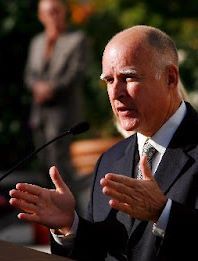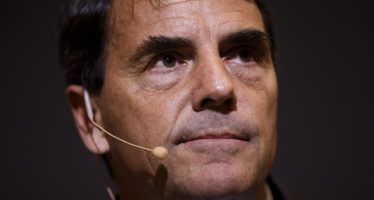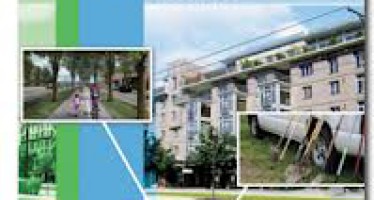State of the State: Gov. Brown seeks ‘fiscal restraint’ — and more spending

SACRAMENTO — Gov. Jerry Brown delivered his 2014 State of the State this morning. It was largely a recap of his recent 2014 Budget proposal press conference, but shorter.
As Brown often does, he first took on his critics:
“It occurred to me that these critics – who have long recited our state’s decline – perhaps have nothing to say in the face of California’s comeback – except, ‘please, don’t report it.’ Well, I’m going to report it, and what a comeback it is: A million new jobs since 2010, a budgetary surplus in the billions and a minimum wage rising to $10 an hour!”
Brown stressed again the need for “fiscal restraint” from the Legislature. But then he went on to discuss several big state spending projects:
“We’re on our way to a million electric vehicles and we’re building the nation’s only high-speed rail. We’re expanding health care coverage to millions more.”
Assemblywoman Kristen Olsen, R-Modesto, wasn’t buying Brown’s hype about fiscal restraint. She said:
“The Governor’s message of fiscal prudence would be inspiring, if not for his persistence of High Speed Rail and the Bay Delta Conservation Plan (i.e. Delta tunnels). It is irresponsible to continue wasting taxpayer dollars on projects like High Speed Rail that have no viable business plan and no connection to real needs in the San Joaquin Valley. The Governor should instead prioritize more immediate issues that have state-wide relevance, such as water storage.”
Promises
Brown quoted the American philosopher George Santayana: “Those who cannot remember the past are condemned to repeat it.” With Brown’s third term nearing an end, and perhaps a fourth ahead, Major League Baseball player and manager Yogi Berra might be more appropriate: “It’s like déjà vu all over again.”
Assemblyman Don Wagner, R-Irvine, also remained skeptical of Brown’s promises:
“The commitment from Governor Brown to reduce the debt is a message Californians want to hear. But, while it is encouraging that the governor is urging ‘fiscal restraint,’ I remain skeptical that a majority of Democrats in the Legislature share this vision. Governor Brown has work to do to convince them, and I will help in in whatever way I can.”
While the governor’s budget addresses some of the state’s debt, Brown touched on only some of the state’s long-term debt and liabilities in his speech:
“And while we know our revenues will fluctuate up and down, our long-term liabilities are enormous and ever growing. Let me list some of them: Over $100 billion for pensions owed to state workers, teachers and judges; tens of billions needed to cover retiree health care; and $65 billion needed to maintain and keep our roads, buildings and other infrastructure in sound repair. We also must account for future risks that could negatively affect our budgets like congressional decisions, natural disasters and the uncertain costs of the Affordable Care Act.”
Assemblyman Mike Morrell, R-Rancho Cucamonga, answered:
“A perceived budget ‘surplus’ that fails to take into account hundreds of billions of dollars in unfunded liabilities is no justification to commit our children and grandchildren to more debt.”
However, Assemblyman Luis Alejo, D-Watsonville, agreed with the governor:
“By instituting a rainy day fund, paying down the state’s burdensome wall of debt, and supporting proposals that advance these goals, we can ensure that education and other vital services in California are protected from the volatile nature of today’s economy.”
Brown addressed the serious need for a rainy day fund:
“In 2004, the people voted for a rainy day fund which was found to be unworkable. In 2010, you created another rainy day fund, now scheduled for the November Election. But this latest effort doesn’t give the state the option to pay off debt, doesn’t deal with the ups and downs of Proposition 98 and doesn’t account for spikes in capital gains. So let’s fix these flaws before going to the voters. This is work that must be accomplished in the next few months.”
Drought
The governor talked about the drought, and the serious implications for California:
“We need everyone in every part of the state to conserve water. We need regulators to rebalance water rules and enable voluntary transfers of water and we must prepare for forest fires. As the State Water Action Plan lays out, water recycling, expanded storage and serious groundwater management must all be part of the mix. So too must be investments in safe drinking water, particularly in disadvantaged communities. We also need wetlands and watershed restoration and further progress on the Bay Delta Conservation Plan.”
“It is a tall order.”
While Sen. Andy Vidak, R-Hanford, applauded the governor on his call for fiscal discipline, he remained skeptical on water policy:
“It’s encouraging that the governor mentioned the need to expand water storage and provide clean drinking water for our disadvantaged communities. I hope this is an indication of leadership, not delay, on a water bond that fully funds water storage on this November’s ballot.”
Assemblyman Henry T. Perea, D-Fresno, also addressed the need for water storage in California:
“It’s clear Governor Brown has made water a priority, and should be applauded for his emphasis on the need for water storage and providing clean drinking water to disadvantaged communities, both critical to California and the Central Valley. The drought brings to light the importance of investing in California’s water infrastructure.”
Global warming
Brown waded into global warming and AB32, the Global Warming Solutions Act of 2006:
“The United Nations Panel on Climate Change says – with 95 percent confidence – that human beings are changing our climate.
“California is the leader in dealing with climate change. From AB32, to our building and appliance efficiency standards, our renewable portfolio standard and our support of electric vehicles, California is leading the way.”
Brown talked about California being a pioneer state, but not for what you might expect:
“California is not only the state where immigrants can dream, they can drive, legally.”
Brown neglected to identify the bill allowing immigrants to drive legally was for undocumented immigrants. Legal immigrants long have been able to drive in CA.
Brown never once mentioned unemployment, which remains high at 8.5 percent, according to the Bureau of Labor Statistics.
Brown wrapped up his State of the Sate address:
“Yes, California is a leader in so many ways. But, the dangers and difficulties we face can never be taken lightly. We still have too many struggling families, too much debt, and too many unknowns when it comes to our climate. Overcoming these challenges will test our vision, our discipline and our ability to persevere. But overcome them we will and as we do, we will build for the future, not steal from it.”
Related Articles
Billionaire Tim Draper renews effort to split California into multiple states
A fresh push to split California into multiple states his cleared its first hurdle, as state Secretary of State Alex
SB 1 pushes high-rises over suburbs
Will the Manhattan Dream replace the California Dream? The Manhattan Dream is to live in a high-rise in a densely
Taxpayers fund govt. agency advertisements
Dec. 21, 2012 By Katy Grimes The state of California is pushing welfare and food stamps very hard. They constantly





